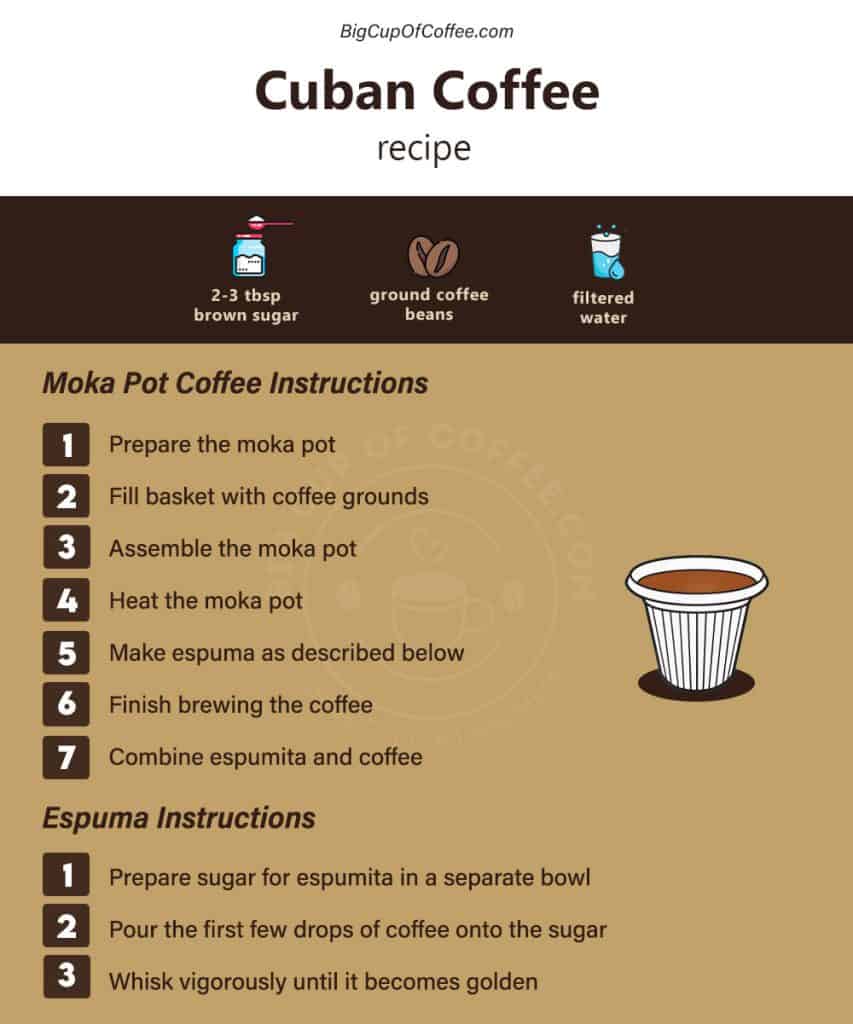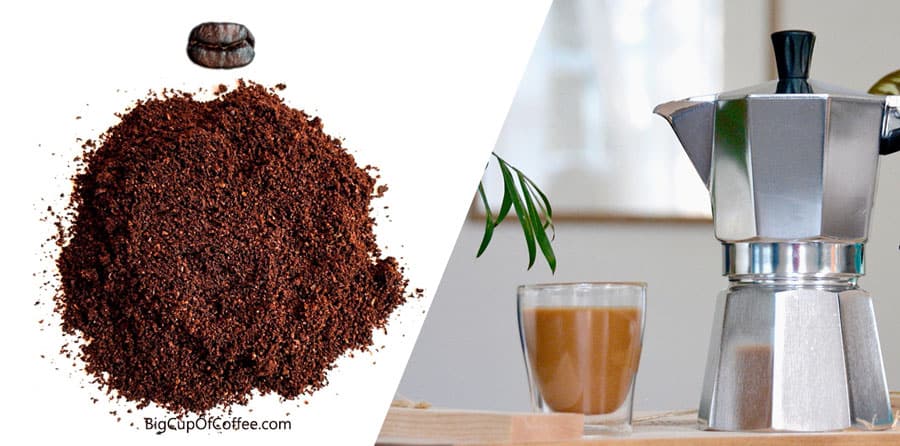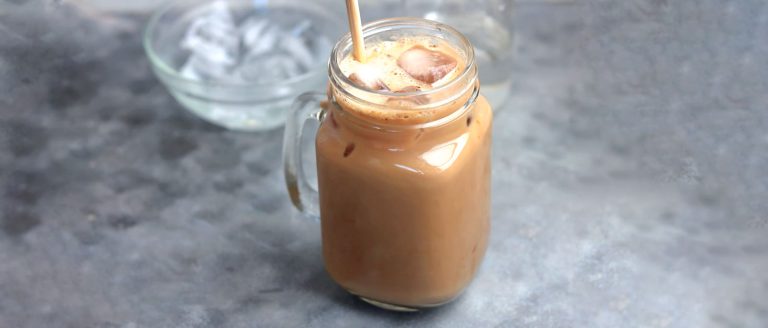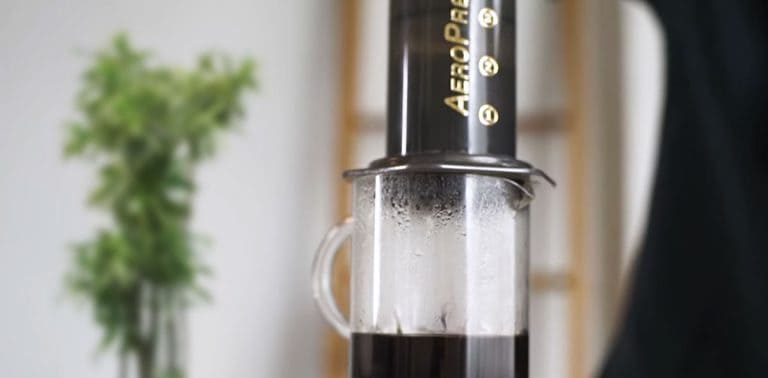Authentic Cuban Espresso Recipe: How to Make Café Cubano at Home
Are you craving the sweet taste of authentic Cuban coffee but struggling to figure out how to make it at home? Don’t worry if this is going to be your first time.
After perfecting my own recipe using only the basic equipment and ingredients outlined below, I’ll detail my foolproof method to make a deliciously strong and sweet café Cubano right at home.
Read on and get ready to learn how to make Cuba-style espresso.
What is Cuban Espresso?
Cuban coffee or cafecito is a short cup of sweet coffee traditionally prepared in a Moka Pot (la greca). It is sweetened with espuma, which is a mixture of demerara sugar (brown cane sugar) and the first few drops of coffee. What’s known as café Cubano to the rest of the world is the standard coffee for Cubans on the island (and in the Cuban neighborhoods of Miami).
Before coffee production was overtaken by rum and sugarcane, Cuba enjoyed a status as a huge producer and exporter of coffee. Today, Cuba’s first coffee plantations are recognized in UNESCO’s World Heritage List.
In 1926, coffee was rationed along with the rest of the food supply. This left Cubans with only four ounces of coffee each month. To cope, they got creative and made café con Chicharo (chickpeas & coffee) with no crema. They replicated it by whipping brown sugar and coffee, which was sweeter and less bitter.

Its popularity has grown worldwide for its unique taste and refreshing caffeine jolt. Cuban coffee actually has many names to accommodate many types:
- Cafecito – The name of the single serving (shot) of Cuban coffee.
- Colada – referred to Cuban espresso made with espumita (sugar foam) and served in larger quantities such as four to six-shot-sized servings.
- Cortadito – refers to Cuban espresso topped with steamed milk.
- Cafe con leche – refers to a tall mug of Cuban espresso with significantly more milk than coffee.
Compared to coffee’s more functional role in the US as a pick-me-up drink, Cuban coffee enjoys a status as a leisure drink and is commonly enjoyed among friends and family. When visiting a Cuban household, you can definitely expect to get a cup or two.
I love this recipe’s simplicity as it only requires three basic ingredients – Cuban-style espresso beans, sugar, and water – plus equipment most people already have at home. It takes roughly 2-3 minutes to brew 2 cups of coffee.
As for my personal experience with this drink, I first tasted it during my honeymoon to the state of Florida, which is known to have a large Cuban American population. Miami, in particular, had plenty of local cafes, and I was excited to get my first authentic taste of cafecito “Cuban rocket fuel,” and it did not disappoint. I immediately wanted to make one for myself.
Be sure to add this beloved cultural staple to your coffee routine, even if you are not a fan of sweetened coffee.
Equipment and Ingredients for a Cuban Espresso
Here is a list of equipment you’ll use:
- Moka Pot (La greca): Authentic Cuban coffee requires authentic equipment, making the Moka Pot the most important piece of equipment in this recipe. Sure, you can use espresso or any other method of making espresso-style coffee, but those take away the authenticity of the recipe.
- Small bowl or cup: This is used for mixing sugar with the first drops of brewed coffee, called espuma or espumita. It is the foam on top of the Cuban coffee, which is a crucial component of the drink.
And these are the ingredients:
- Finely Ground Espresso Coffee (Cuban Coffee): The main ingredient for making Cuban coffee is finely ground coffee, just enough to fill the basket of the moka pot without tamping. Don’t grind it too fine though, as that will plug up the Moka pot. Here is an article on the proper grind size for coffee.
- Filtered water: Enough water to fill the bottom chamber up to the water line under the pressure release valve.
- Sugar: Used for creating the “espumita” and sweetening the coffee. The amount depends on how sweet you want to make the brew, 2-3 spoonfuls are the norm.
Step-by-step Guide to Making a Cuban Espresso at Home
Let me walk you through the process:
1. Prepare the moka pot
Unscrew the moka pot and locate the water line in the bottom chamber. Fill water up to the water line, ensuring it doesn’t exceed the mark and especially the pressure release valve. You don’t want to find out if your moka pot can explode.
2. Fill basket with coffee grounds
Fill the moka pot’s filter basket with finely ground espresso coffee (Cuban coffee). Tap the sides of the basket gently to even out the coffee grounds and create a consistent layer, than pack it slightly just to level it out. You don’t pack it like an espresso portafilter, just a gentle leveling.

3. Assemble the mok pot
Place the filter basket filled with coffee grounds into the bottom chamber. Screw the top chamber onto the bottom chamber tightly, ensuring there are no gaps for water or steam to escape.
4. Heat the moka pot
Place the assembled moka pot onto the stovetop over medium heat (never high heat, as that can burn your coffee). Leave the lid open to monitor the coffee brewing process.
5. Prepare sugar for espumita
In a small bowl, add 2-3 spoonfuls of sugar, depending on your desired sweetness level. 3 spoons is too sweet for my taste, but you’ll see what you like.
6. Create the espuma
The espuma (espumita) is a staple of Cuban coffee, and there is a very specific way to make it:
- When the first few drops of coffee emerge from the moka pot, take the moka pot off the heat
- Add that small amount of coffee to the small container with sugar.
- Put the moka pot back on the stove so mit continues to brew.
- Mix the coffee and sugar vigorously to create a caramel-colored sticky foam.
7. Finish brewing the coffee
Allow the rest of the coffee to brew in the moka pot. Once it starts sputtering, it is done. Remove it from the stove so you don’t burn your coffee.
8. Combine espumita and coffee
Gently stir the brewed coffee with the espumita to create a uniform, foamy mixture.
What kind of cup should Cuban espresso be served in?
Traditional Cuban coffee is served in ceramic demitasse cups, just like an espresso. This is because it’s twice as strong and concentrated as regular drip coffee in Northern America.

Helpful Tips for Brewing a Cuban Espresso
Follow these expert tips to ensure you’re making a perfect cup every time:
- You can use either granulated white sugar or brown sugar. Opt for brown sugar if you want a thicker foam and a sweeter flavor.
- Depending on your method, you’ll either add it before or during brewing. No matter your choice, make sure to stir thoroughly so you don’t end up with undissolved grains sitting on top.

Authentic Cuban Espresso Recipe
Ingredients
- 20 g Ground cuban coffee beans (dark roast, espresso-style)
- 2 tbsp Sugar (brown is best)
- 100 ml Filtered water (for 3 cup moka pot)
Instructions
Moka pot
- Prepare the moka pot
- Fill the basket with coffee grounds
- Assemble the moka pot
- Heat the moka pot
- Make espuma as described below
- Finish brewing the coffee
- Combine espumita and coffee
Espuma
- Prepare sugar for espumita in a separate bowl
- Pour the first few drops of coffee onto the sugar
- Whisk vigorously until it becomes golden u0026 frothy
Video
Notes
- You can use white or brown sugar.
- Some like this recipe with 3 tbsp of sugar, which makes it a lot sweeter.
Conclusion
I hope that my personal experience with café Cubano has inspired you to give it a try yourself. With just a few steps, beans, and sugar, you can enjoy the bold and sweet flavors that seemingly transport you to Havana with every sip.
Start brewing today, and let me know how it works out in the comments below.






